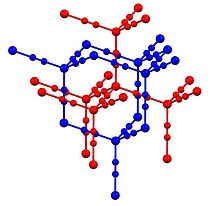Cadmium cyanide

| |
| Names | |
|---|---|
| IUPAC name
Cadmium(II) cyanide
| |
| Identifiers | |
3D model (
JSmol ) |
|
| ChemSpider | |
ECHA InfoCard
|
100.008.027 |
PubChem CID
|
|
| UNII | |
CompTox Dashboard (EPA)
|
|
| |
| |
| Properties | |
| Cd(CN)2 | |
| Molar mass | 164.45 g/mol |
| Appearance | white cubic crystals |
| Density | 2.226 g/cm3 |
| 1.71 g/100 mL (15 °C) 2.2 g/100 mL (20 °C) | |
| Solubility | slightly soluble in alcohol dissolves in alkali, metal cyanides and hydroxides |
| -54.0·10−6 cm3/mol | |
| Hazards | |
| NIOSH (US health exposure limits): | |
PEL (Permissible)
|
[1910.1027] TWA 0.005 mg/m3 (as Cd)[1] |
REL (Recommended)
|
Ca[1] |
IDLH (Immediate danger) |
Ca [9 mg/m3 (as Cd)][1] |
| Related compounds | |
Other anions
|
Cadmium chloride, Cadmium iodide |
Other cations
|
Zinc cyanide, Calcium cyanide, Magnesium cyanide |
Except where otherwise noted, data are given for materials in their standard state (at 25 °C [77 °F], 100 kPa).
| |
Cadmium cyanide is an inorganic compound with the formula Cd(CN)2. It is a white crystalline compound that is used in electroplating.[2] It is very toxic, along with other cadmium and cyanide compounds.
Preparation and structure
Cadmium cyanide is prepared commercially by treating cadmium hydroxide with hydrogen cyanide:[3]
- Cd(OH)2 + 2 HCN → Cd(CN)2 + 2 H2O
It can also be generated from tetracyanocadmate:
- [Cd(CN)4]2− + CdCl2 → 2 Cd(CN)2 + 2 Cl−
Cadmium cyanide and
Reactions and uses
It is used as an electrolyte for electrodeposition of thin metallic cadmium coatings on metal to protect against corrosion.
Like zinc cyanide, cadmium cyanide is fairly soluble in water, which is unusual for transition metal cyanides. The solubility increases with the additional cyanide, this reaction proceeding via "[Cd(CN)3]−" and [Cd(CN)4]2−. With acids, its solutions evolve
References
- ^ a b c NIOSH Pocket Guide to Chemical Hazards. "#0087". National Institute for Occupational Safety and Health (NIOSH).
- ISBN 0-8493-0487-3.
- .
- ^ ISBN 978-0-08-037941-8.
- doi:10.1039/A702539D..
